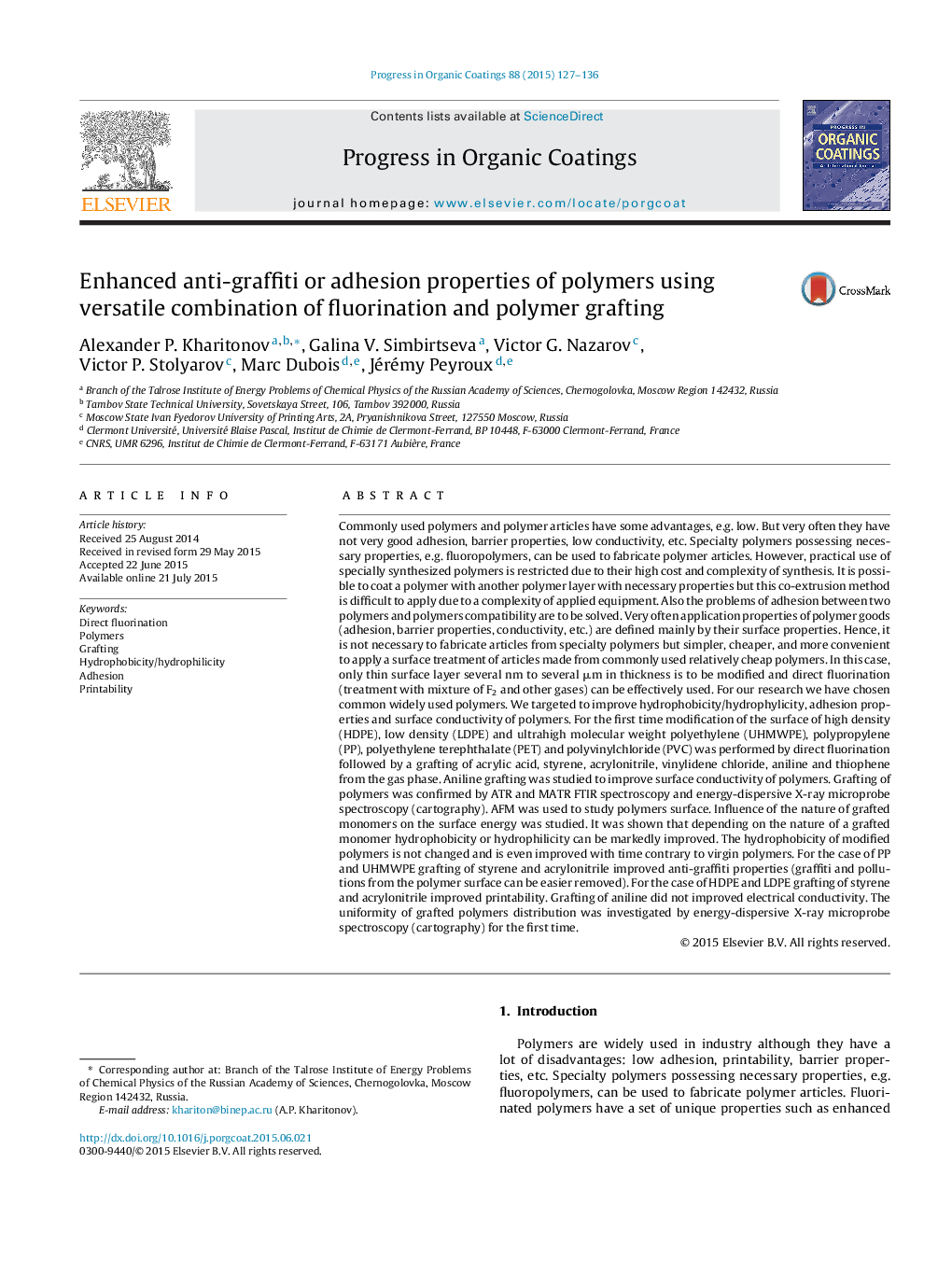| کد مقاله | کد نشریه | سال انتشار | مقاله انگلیسی | نسخه تمام متن |
|---|---|---|---|---|
| 692313 | 1460515 | 2015 | 10 صفحه PDF | دانلود رایگان |
• Polymer surface was modified by direct fluorination followed by monomer grafting from the gas phase.
• Hydrophilicity/hydrophobicity, adhesion, and printability can be tuned by grafted monomer nature.
• Effect of modification is long-lasting.
• Uniformity of fluorination and grafted monomers distribution across the polymer surface was tested.
Commonly used polymers and polymer articles have some advantages, e.g. low. But very often they have not very good adhesion, barrier properties, low conductivity, etc. Specialty polymers possessing necessary properties, e.g. fluoropolymers, can be used to fabricate polymer articles. However, practical use of specially synthesized polymers is restricted due to their high cost and complexity of synthesis. It is possible to coat a polymer with another polymer layer with necessary properties but this co-extrusion method is difficult to apply due to a complexity of applied equipment. Also the problems of adhesion between two polymers and polymers compatibility are to be solved. Very often application properties of polymer goods (adhesion, barrier properties, conductivity, etc.) are defined mainly by their surface properties. Hence, it is not necessary to fabricate articles from specialty polymers but simpler, cheaper, and more convenient to apply a surface treatment of articles made from commonly used relatively cheap polymers. In this case, only thin surface layer several nm to several μm in thickness is to be modified and direct fluorination (treatment with mixture of F2 and other gases) can be effectively used. For our research we have chosen common widely used polymers. We targeted to improve hydrophobicity/hydrophylicity, adhesion properties and surface conductivity of polymers. For the first time modification of the surface of high density (HDPE), low density (LDPE) and ultrahigh molecular weight polyethylene (UHMWPE), polypropylene (PP), polyethylene terephthalate (PET) and polyvinylchloride (PVC) was performed by direct fluorination followed by a grafting of acrylic acid, styrene, acrylonitrile, vinylidene chloride, aniline and thiophene from the gas phase. Aniline grafting was studied to improve surface conductivity of polymers. Grafting of polymers was confirmed by ATR and MATR FTIR spectroscopy and energy-dispersive X-ray microprobe spectroscopy (cartography). AFM was used to study polymers surface. Influence of the nature of grafted monomers on the surface energy was studied. It was shown that depending on the nature of a grafted monomer hydrophobicity or hydrophilicity can be markedly improved. The hydrophobicity of modified polymers is not changed and is even improved with time contrary to virgin polymers. For the case of PP and UHMWPE grafting of styrene and acrylonitrile improved anti-graffiti properties (graffiti and pollutions from the polymer surface can be easier removed). For the case of HDPE and LDPE grafting of styrene and acrylonitrile improved printability. Grafting of aniline did not improved electrical conductivity. The uniformity of grafted polymers distribution was investigated by energy-dispersive X-ray microprobe spectroscopy (cartography) for the first time.
Water contact angle vs storage duration of freshly pressed high density (left) and ultrahigh molecular weight (right) polyethylene: virgin (●), fluorinated only (▾), with grafted acrylonitrile (■) and with grafted styrene (♦).Figure optionsDownload as PowerPoint slide
Journal: Progress in Organic Coatings - Volume 88, November 2015, Pages 127–136
